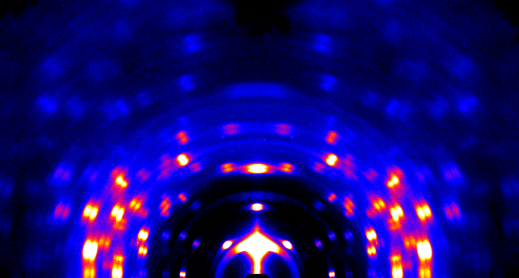 |
| Scattering Data collected by Kevin Yager (Center for Functional Nanomaterials, Brookhaven National Laboratory) using the X9 beamline at the National Synchrotron Light Source. |
_______________________________________________
Margaret Schedel translates scientific research into sound
By Taylor Ha
When Margaret Schedel turned 14, her father bought her an unusual birthday present – Finale, a music notation software. Hoping to master this new system, Schedel enrolled in a summer program in electronic music at Oberlin. “They didn’t do Finale at all,” Schedel recalled, “but they did sampling, digital performer, recording, manipulating sound…and I just fell in love with it right there.” It was the beginning of a 21st century romance: a blend between music and science, or computer music.
Today Dr. Schedel is a an experienced composer and cellist, but she hasn’t forgotten about her affinity for science. She’s an Associate Professor of Music and Co-Director of Computer Music at Stony Brook University where she said she has been given the opportunity to work with scientists and discover things about the world by using sound. One core aspect of her research is sonification, the use of non-speech audio to communicate information or data that supplements visualization techniques. “A lot of people who are composers in computer music do sonification because instead of taking sound and turning it into numbers, you just have numbers already,” she said, “and then you try to make them into sound.”
Sonification is specifically related to a groundbreaking discovery that occurred last September – the confirmation that gravitational waves do in fact exist. In 1915, Albert Einstein predicted in his general theory of relativity that gravitational waves, or ripples within space-time’s fabric, occur in our universe. A few months ago, Laser Interferometer Gravitational-Wave Observatory (LIGO) scientists at the California Institute of Technology (Caltech) and the Massachusetts Institute of Technology (MIT) finally observed evidence of these ripples. Although they discovered its existence through visual means, they also supported their discovery with sonification and a specific sound.
Bloop. That’s essentially the revolutionary sound of two black holes bashing into each other approximately 1.3 billion years ago. “You’re like, ‘Bloop! Great Einstein! Great job! It’s not the most exciting sonification, but I am happy about it because it’s brought attention to sonification,” Dr. Schedel said. That explains why ScienceFriday, a radio show with over 1.5 million weekly listeners that covers hot topics on science and technology, interviewed Schedel and a sonification specialist last April about gravitational waves and sonification.
Besides being recently interviewed by ScienceFriday, Dr. Schedel is also the new paper chair for the International Conference on Auditory Display (ICAD) conference on sonification. Previously the music coordinator for the conference, this year Dr. Schedel will be responsible for finding all of the reviewers, instructing them on review procedures and then organizing accepted papers into appropriate groups. “I’m gaining some recognition in this field, which is good,” she noted.
This fall, Dr. Schedel is hosting a special conference as the director of cDACT, the consortium for digital art, culture and technology, which is an interdisciplinary group. “cDACT every two years does these large scale event series where we try to approach a topic from multiple angles. So we’ve done sound, geography, glitch, and next year we’re doing the 50th anniversary of the Experiments in Art and Technology (E.A.T),” she explained. “I think cDACT is a direct legacy of that collaboration between artists and scientists.”
For more information about cDACT and the upcoming anniversary event, you can visit http://cdact.stonybrook.edu/. For more information on Professor Schedel, you can visit her website at http://schedel.net/. For a recent article written by Professor Schedel on sonification, visit https://soundstudiesblog.com/author/schedel/
Sources: